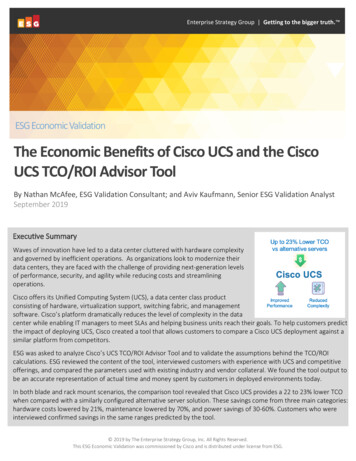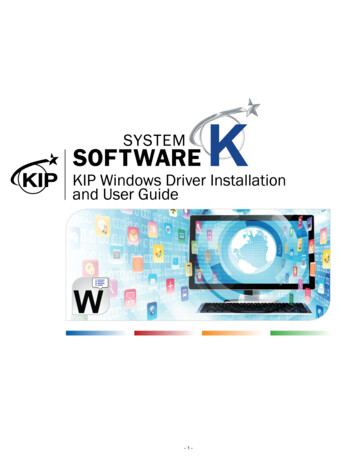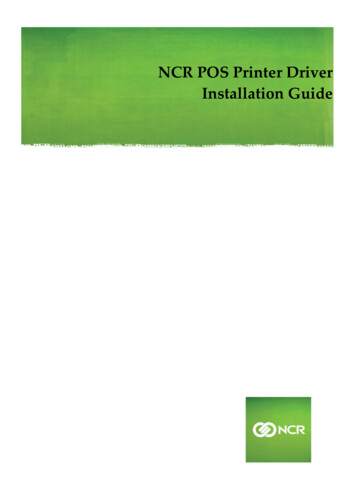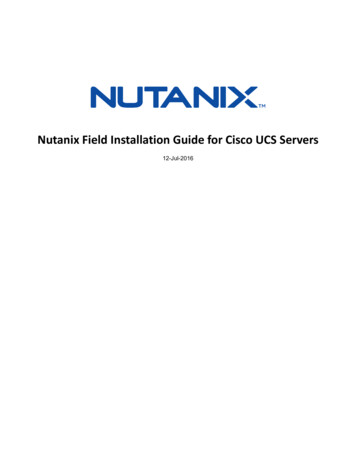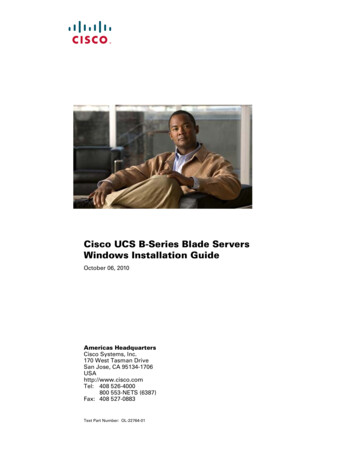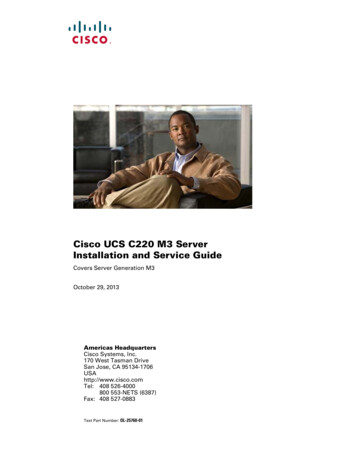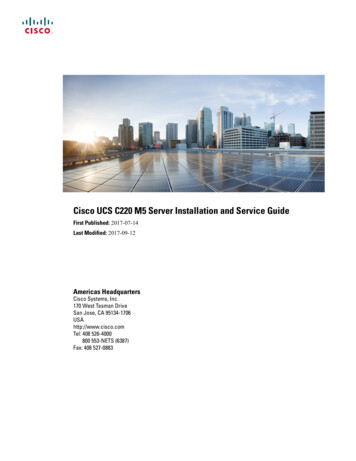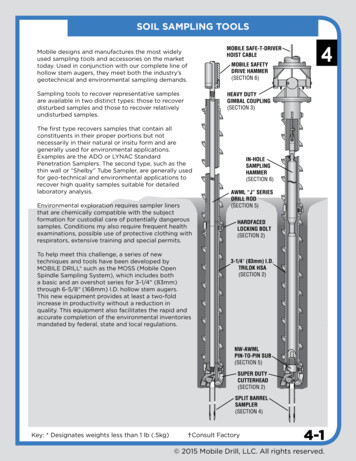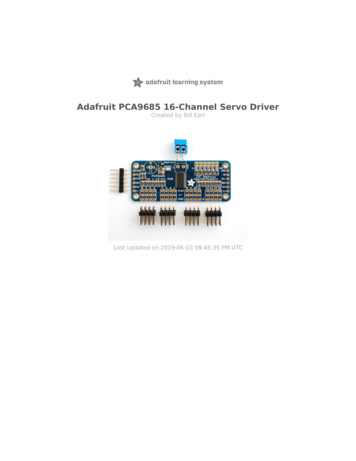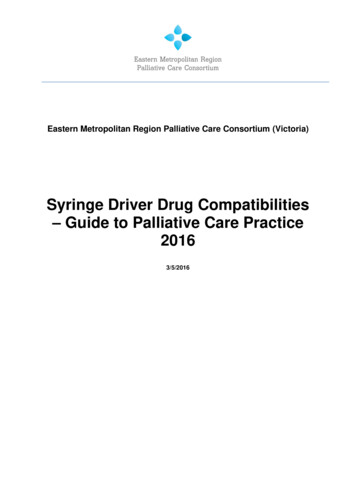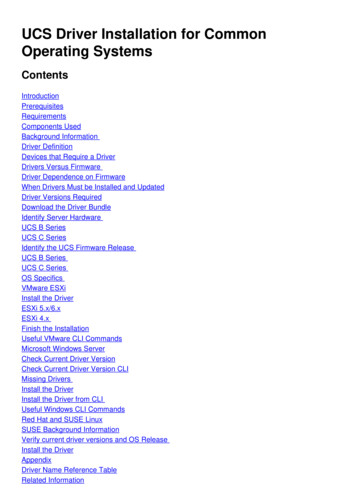
Transcription
UCS Driver Installation for CommonOperating tsComponents UsedBackground InformationDriver DefinitionDevices that Require a DriverDrivers Versus FirmwareDriver Dependence on FirmwareWhen Drivers Must be Installed and UpdatedDriver Versions RequiredDownload the Driver BundleIdentify Server HardwareUCS B SeriesUCS C SeriesIdentify the UCS Firmware ReleaseUCS B SeriesUCS C SeriesOS SpecificsVMware ESXiInstall the DriverESXi 5.x/6.xESXi 4.xFinish the InstallationUseful VMware CLI CommandsMicrosoft Windows ServerCheck Current Driver VersionCheck Current Driver Version CLIMissing DriversInstall the DriverInstall the Driver from CLIUseful Windows CLI CommandsRed Hat and SUSE LinuxSUSE Background InformationVerify current driver versions and OS ReleaseInstall the DriverAppendixDriver Name Reference TableRelated Information
IntroductionThis document describes how to install device drivers on the Cisco Unified Computing System(UCS) for common operating systems.PrerequisitesRequirementsCisco recommends that you have knowledge of these topics: Cisco UCS ManagerCisco Integrated Management Controller (CIMC)Virtual Machine-ware (VMware), Windows Server, or Linux Operating Systems (OS)Components UsedThe information in this document is based on these hardware platforms: UCS B SeriesUCS C SeriesThe information in this document was created from the devices in a specific lab environment. All ofthe devices used in this document started with a cleared (default) configuration. If your network islive, make sure that you understand the potential impact of any command.Background InformationDriver DefinitionA device driver is software that is the interface between the OS and the hardware. The devicedriver translates general OS commands into specialized commands for a particular device, whichallows the OS to communicate with hardware devices.Devices that Require a DriverHere is a list of hardware devices that require device drivers: Ethernet Network Interface Card (ENIC)Fibre Channel Network Interface Card (FNIC)Redundant Array of Indepent Disks (RAID) ControllerMotherboard ChipsetVideo CardTrusted Platform Module (TPM)Drivers Versus Firmware
Device drivers are different from firmware. Device driver software is installed on the OS, whereasfirmware is lower-level code that is installed on hardware devices. Firmware is stored in nonvolatile memory, such as ROM, Erasable Programmable ROM (EPROM), or flash memory.Driver Dependence on FirmwareDevice drivers have a strong dependence on the device firmware. Device drivers must becompatible with the firmware level of a hardware device, so that they properly communicate witheach other; driver and firmware functionality must match for correct operation to take place.When Drivers Must be Installed and UpdatedDevice drivers come pre-installed with operating systems (such as Cisco OEM VMware ESXiimages), or they can be manually installed post-OS setup.Device drivers generally need to be updated after these procedures: UCS firmware upgradesMajor OS upgrades/patchesDriver Versions RequiredThe UCS Hardware and Software Interoperability matrix outlines the driver versions that arerequired for a particular OS, device, and firmware combination.Warning: The driver versions listed on the matrix have been tested and verified by the CiscoEngineering Quality Assurance team, and it is crucial to install the correct driver; otherwise,you might run into unexpected behavior which could lead to network outages.This example shows that an FNIC driver version of 1.6.0.36 is required for a B200 M4 witha Virtual Interface Card (VIC) 1240 that runs ESXi 6.0 U3, on UCS Release 3.2.2.
Download the Driver BundleComplete these steps in order to download the driver bundle:1. In a web browser, navigate to http://www.cisco.com.2. Under Support, click Download Software.3. Click Unified Computing and Servers.4. Choose your server. Cisco UCS drivers are available for both Cisco UCS B-Series Bladeservers and Cisco UCS C-Series Rack-Mount.5. Click Unified Computing System (UCS) Drivers.6. Select the bundle you want to download, and click Download Now.Tip: When you choose which driver bundle to download, it is important to select the driverbundle version that is most similar to the server firmware release. For example, if you run aUCS-B Release 3.2(2b), then VMware driver bundle ucs-bxxx-drivers-vmware.3.2.2.iso isrequired.Tip: Most VMware ESXi drivers are downloaded directly fromwww.vmware.com/download, with a search for the driver version. This is often quickerthan if you were to download the entire driver bundle.Identify Server HardwareBefore you select the correct driver, you must identify what hardware devices are installed on theserver. This section describes how to find the devices located on the UCS Manager and in theCIMC.
UCS B SeriesThis example shows how to find the server inventory in UCS Manager. Server 1/1 has two adaptermodels installed: the VIC 1240 and 1280.UCS C SeriesThis example shows how to find the server hardware devices in the CIMC. The server has a LSI9266-8i RAID controller installed.Identify the UCS Firmware ReleaseBefore the correct driver version is selected, the UCS release must be identifed. This sectiondescribes how to identify the current UCS release installed on the servers.UCS B SeriesIn this example, the UCS B Series runs UCS Release 2.1(1a).
UCS C SeriesIn this example, the UCS C Series runs UCS Release 1.4(6d).OS SpecificsThis section describes how to check driver versions and how to install drivers on common OSs.VMware ESXiUse these commands in order to check the current driver versions and VMware build:Tip: These commands are executed from the ESXi CLI. Secure Shell (SSH) must beenabled before an SSH session is initated.Commandvmware -vlesxcli software profile getesxcfg-scsidevs -aesxcfg-nics -lethtool -i vmnicXesxcli network nic get -nvmnicXvmkload mod -s fnicDescriptionDisplays the VMware build and patch levelDisplays flavor of install ISOLists the hosts HBAs and the associated driver nameLists the host vmnics and network interface card (NIC) modelsDisplays the Ethernet driver used by the specified vmnicDisplays the Ethernet driver used by the specified vmnic onESXi 6.5Displays the host bus adapter (HBA) driver version for the
vmkload mod -s enicvmkload mod -s nenicCisco VICDisplays the Ethernet driver version for the Cisco VICDisplays the Ethernet driver version for the Cisco VIC for ESXi6.5 and later releasesvmkload mod -smegaraid sasDisplays the LSI MegaRAID driver versionvmkload mod -s lsi mr3Displays the LSI lsi mr3 driver version(Native driver on ESXi6.7)vmkload mod -sdriver nameDisplays the driver version for a specified driverThese examples show that vmnic2 uses a Cisco VIC and a driver version of 1.4.2.15a.These examples show that the Qlogic Host Bus Adapter (HBA) uses driver qla2xxx Version901.1k.1-14vmw.Install the DriverComplete these steps in order to install the driver:1. Extract the contents of the driver zip file, and identify the *.vib file.2. Use the Datastore Browser in order to upload the *.vib file to an ESXi host datastore.
3. Enter the host into Maintenance mode.4. Install the driver.ESXi 5.x/6.xUse this command in order to install the driver on ESXi Release 5.x/6.x:esxcli software vib install –v /path/async-driver.vibNote: If the drivers require a signature verification, run this command with the --no-sigcheck switch. Ensure that you use the full path to the file.ESXi 4.xUse this command in order to install the driver on ESXi Release 4.x:esxupdate --bundle offline-bundle.zip updateFinish the InstallationAfter you install the driver with one of the previously mentioned commands, exit Maintenancemode and reboot the host. For more information on how to install drivers, reference the RelatedInformation section at the end of this document.
Useful VMware CLI CommandsHere are some other useful VMware commands that you can use when you install a driver:Check Maintenance Mode Statusvim-cmd hostsvc/hostsummary grep -i maintenaceCheck for Powered-On VMsvim-cmd vmsvc/getallvmsPower-Off VMsvim-cmd vmsvc/power.off vm id Enter Maintenance Modevim-cmd hostsvc/maintenace mode enterExit Maintenance Modevim-cmd hostsvc/maintenace mode exitMicrosoft Windows ServerThis section describes how to install a driver on a Microsoft Windows server.Check Current Driver VersionIn order to check the device drivers in Microsoft Windows, use the Device Manager located in theControl Panel.
Check Current Driver Version CLIFor Windows Server Core the Plug-and-Play (PnP) Utility (PNPUtil.exe) is used to check driverversions.Missing DriversHardware devices with missing drivers are displayed in the Device Manager with a yellow questionmark. These devices should be updated with the correct driver in order to prevent unexpectedbehavior.
Install the DriverIn order to install or update a driver in Microsoft Windows, right-click on the device, and chooseInstall/Update Driver in order to start the Installation Wizard.Install the Driver from CLIThe PNPUtil tool can also be used to install drivers from the CLI. The driver ISO bundle can bemounted via the UCS KVM Console Virtual Media.
Useful Windows CLI CommandsCommandDescriptionpnputil.exe -eList all installed 3rd party driverspnputil.exe -a INF name Install driverpnputil.exe -d INF name Delete driverpnputil.exe -f -d INF name Force delete driverRed Hat and SUSE LinuxThis section describes how to install and validate a driver on Red Hat Enterprise Linux (RHEL)and SUSE Linux Enterprise Server (SLES).SUSE Background InformationStarting with SLES 12 SP1, the Cisco eNIC and usNIC drivers are bundled together into a singleRPM (vs. being packaged in separate RPMs, as they are for other Linux distributions). Bundlingboth drivers into a single RPM is required because of how kernel module dependencies aremanaged in SLES 12 SP1 and later. If you are not using Cisco usNIC functionality (i.e., if you havenot provisioned any usNIC devices in UCSM / CIMC), the usNIC driver will effectively be ignored.The eNIC and usNIC drivers have their own distinct version numbers. If you install the cisco-enicusnic RPM on SLES 12 SP 1 or later, once those drivers are loaded into the running kernel (e.g.,via rebooting), use cat /sys/module/enic/version and cat /sys/module/usnic verbs/version toview their respective version numbers. The cisco-enic-usnic RPM has its own distinct versionnumber as well. Because it represents the packaging of the eNIC and usNIC drivers, the RPMversion number may look similar, but does not reflect the specific version of either driver.For additional information on the exact driver versions query and review the RPM descriptionsection. The query looks similar to the example below:# rpm -qip cisco-enic-usnic-kmp-default- RPM VERSION .x86 64.rpmName: cisco-enic-usnic-kmp-default Relocations: (not relocatable).Summary: Cisco VIC Ethernet NIC driversDescription :This RPM contains both the Cisco VIC Linux Ethernet driver (enic.ko, version ENIC VERSION ) andthe Cisco Userspace NIC (usNIC) Linux Ethernet driver (usnic verbs.ko, version USNIC VERSION ).Some Linux distros require both kernel modules to be in the same RPM in order to properly test
forsymbol compatibility (because usnic verbs.ko depends on enic.ko) when installing into post-GAupgrade kernels.Verify current driver versions and OS ReleaseHere is a list of commands used in order to check the current driver version and OS release:CommandDescriptionDisplays driver version for the specified driver that will be loaded (bymodinfo driver namedefault) at next rebootmodinfo /path/to/driver name.ko Displays driver version for the specified driver kernel object fileDisplays the Ethernet driver version currently loaded in the running Lincat /sys/module/enic/versionkernel for the Cisco VIC adapterDisplays the FC NIC driver version currently loaded in the running Linucat /sys/module/fnic/versionkernel for the Cisco VIC adaptercatDisplays the LSI MegaRAID driver version currently loaded in the/sys/module/megaraid sas/version running Linux kernellsmod -lLists currently-loaded drivers in the kernelcat /etc/redhat-releaseShows the RHEL release (for RHEL 6.x and earlier)cat /etc/SuSE-releaseShows the SUSE release (for SLES 11 SP3 and earlier)Shows the RHEL release (for RHEL 7.x and later, and SLES 11 SP4cat /etc/os-releaseand later)uname -aShows kernel related informationNote: Be aware of the command modinfo [ driver name ]shows the module informationabout the driver that will be loaded upon next reboot. This is not necessarily the same driverversion currently loaded in the running kernel. Reviewcat/sys/module/DRIVER NAME/version to validate the driver version loaded in thecurrently running kernel, and/or use the command modinfo [ /path/to/driver.ko ] to validatethe module info for a specific driver kernel object file.Tip: Refer to the Driver Name Reference Table located in the Appendix for examples ofother common driver names.This example shows that an ENIC driver version of 3.2.210.18-738.12 bundled in the cisco-enicusnic RPM package 3.2.272.23 is installed on SLES 15 GA.# cat /etc/os-releaseNAME "SLES"VERSION "15"VERSION ID "15"PRETTY NAME "SUSE Linux Enterprise Server 15"ID "sles"ID LIKE "suse"ANSI COLOR "0;32"CPE NAME "cpe:/o:suse:sles:15"# rpm -qa grep eniccisco-enic-usnic-kmp-default-3.2.272.23 k4.12.14 23-738.12.x86 64# modinfo enic grep versionversion: 3.2.210.18-738.12
# cat /sys/module/enic/version3.2.210.18-738.12Install the DriverDrivers in RHEL and SLES are installed using the Redhat Package Manager (RPM). Use thiscommand in order to install the driver:# rpm -ihv RPM filename.x86 64.rpmTip: When you install drivers in Linux, ensure that you review the README files associatedwith the driver if available. You can look at the contents of the RPM to see where itsassociated README file was installed (e.g., rpm -qp kmod-enic). Some RPM driverpackages have dependencies on other modules, and require installation of additional RPMpackages. The README files contain full instructions on how to install the driver file.AppendixDriver Name Reference TableThis table shows the driver names or prefixes for common drivers.Command DescriptionenicCisco VIC Ethernet NICfnicCisco VIC FC NICqle or qla Qlogic adapterlpfcEmulex HBA (light pulse)be2netEmulex Ethernet NICigb or ixgbe Intel NICsbnxBroadcom adaptermegaraid LSI MegaRAIDmegasrEmbedded SW RAIDnenicCisco VIC Ethernet NIC for ESXi 6.5Related Information VMware KB: How to download and install async drivers in ESXi 5.x/6.x (2005205)VMware KB: Determining Network/Storage firmware and driver version in ESXi/ESX 4.xand 5.x (1027206)VMware KB: Installing async drivers on ESXi 5.x (2005205)VMware KB: Installing async drivers on ESXi 4.x (1032936)VMware KB: Identifying a PCI device in ESX/ESXi 4.x or ESXi 5.x and comparing it withthe VMware HCL (1031534)Technical Support & Documentation - Cisco Systems
Select the bundle you want to download, and click Download Now. 6. Tip: When you choose which driver bundle to download, it is important to select the driver bundle version that is most similar to the server firmware release. For example, if you run a UCS-B Release 3.2(2b), then VMware driver bundle
